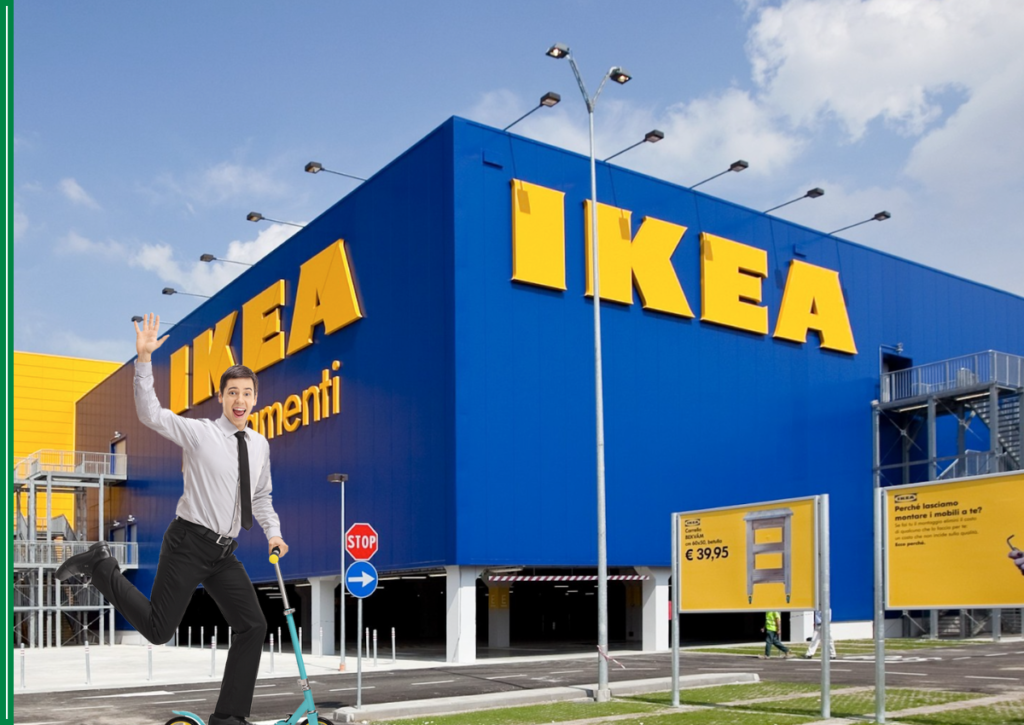IKEA is one of the most recognised and beloved furniture brands in the world. Known for its affordable, stylish, and functional home solutions, IKEA has transformed how people furnish their homes. But behind its success lies a story of determination, innovation, and a relentless focus on customer needs. This success story explores IKEA’s journey from a small Swedish business to a global giant and how its unique approach revolutionised the furniture industry.

The Birth of IKEA: A Vision for Affordable Furniture
IKEA was founded in 1943 by Ingvar Kamprad, a 17-year-old entrepreneur from Sweden. The name IKEA comes from his initials (I K), along with the name of the farm he grew up on, Elmtaryd, and the nearby village Agunnaryd. Initially, the company sold small household goods like pens, wallets, and picture frames through mail order. Furniture was later introduced in 1948, marking the beginning of IKEA’s transformation.
During its early years, IKEA faced stiff competition from established furniture retailers. However, Kamprad’s vision was clear—he wanted to offer high-quality furniture at prices that ordinary people could afford. He achieved this by eliminating the middleman and working directly with manufacturers, allowing IKEA to maintain affordability without compromising quality.
The Game-Changer: How IKEA Revolutionised Flat-Pack Furniture.
One of the most significant turning points for IKEA was the introduction of flat-pack furniture in the 1950s. A simple observation led to this groundbreaking idea. One day, an IKEA designer removed the legs from a table to fit it into a customer’s car. This sparked the idea of selling furniture in parts, allowing customers to assemble it at home. This innovation not only reduced transportation costs but also made furniture more affordable and accessible to the masses.
Flat-pack furniture became a cornerstone of IKEA’s business model, giving customers an interactive shopping experience. By assembling furniture themselves, customers saved money while feeling a sense of accomplishment. This approach helped IKEA stand out in the market and fueled its rapid growth.
The IKEA Experience: Simplicity Meets Functionality
IKEA’s success isn’t just about affordable furniture; it’s about the experience. Their massive self-service warehouses, well-designed showrooms, and Scandinavian-style products create an engaging customer journey. The company focuses on three key aspects:

- Affordability – IKEA constantly finds ways to cut costs without compromising quality.
- Sustainability – The brand invests in eco-friendly materials and sustainable forestry.
- Design and Innovation – IKEA collaborates with designers to create functional, stylish, and space-saving furniture.
Each IKEA store is designed as a maze, guiding customers through different sections showcasing fully furnished rooms. This layout not only inspires shoppers but also encourages them to make impulse purchases. Additionally, IKEA’s in-store restaurants offering Swedish meatballs have become an integral part of the shopping experience, drawing customers in for a meal and extending their visit.
IKEA’s Worldwide Expansion: Bringing Affordable Design to Every Home
IKEA expanded internationally in the 1960s, opening stores in Norway and Denmark, followed by Switzerland, Germany, and beyond. Today, IKEA has over 400 stores in more than 50 countries, serving millions of customers worldwide.
One of the secrets to its global success is local adaptation. While IKEA maintains a consistent brand identity, it tailors its products and store layouts to suit regional tastes and needs. For example, in India, IKEA offers spice-proof kitchen solutions, recognizing the heavy use of spices in Indian cooking. In Japan, where living spaces are smaller, IKEA focuses on compact and multi-functional furniture.
Additionally, IKEA’s expansion strategy involves keeping prices competitive even in new markets. The company achieves this by partnering with local suppliers and adjusting its product mix to align with consumer demand.
IKEA’s Digital Revolution: Transforming E-commerce and Customer Experience
With the rise of e-commerce, IKEA embraced digital transformation. It enhanced its online shopping experience, introduced augmented reality to let customers visualize furniture in their homes, and focused on click-and-collect services. This shift has helped IKEA remain competitive in a fast-changing retail landscape.
IKEA has also invested in smart home technology, launching a range of smart lighting, speakers, and automated blinds. These innovations cater to the growing demand for connected home solutions, further cementing IKEA’s reputation as a forward-thinking brand.
Overcoming Challenges: How IKEA Turned Obstacles into Opportunities
Every success story comes with challenges, and IKEA is no exception. Some of the biggest hurdles the company faced include:
- Keeping prices low while maintaining quality – IKEA achieves this by optimizing its supply chain and using sustainable materials.
- Navigating cultural differences – IKEA adapts its approach in different markets while staying true to its core values.
- Environmental concerns – The company has invested heavily in sustainable practices, aiming to be a circular and climate-positive business by 2030.
- Competition from online retailers – To counter the threat of e-commerce giants, IKEA has strengthened its online presence and improved delivery services.
Despite these challenges, IKEA’s ability to innovate, adapt, and stay customer-focused has ensured its continued growth and success.
IKEA’s Future: Innovating for a Sustainable and Smart Tomorrow
IKEA continues to innovate, focusing on sustainability, digital transformation, and urban living solutions. It is expanding its small-format stores, investing in renewable energy, and exploring furniture rental services. With a strong commitment to its values and customers, IKEA is poised for continued growth and impact.
Looking ahead, IKEA plans to incorporate more recycled and renewable materials into its products. The company is also exploring the use of AI and automation in its warehouses to streamline operations. Additionally, it aims to enhance the customer experience with AI-powered shopping assistants and virtual interior design tools.
As urbanization increases, IKEA is adapting by introducing city-center stores that cater to people with limited living space. These stores focus on compact furniture solutions and offer delivery services, making it easier for urban dwellers to shop.
Final Thoughts: The Lasting Impact of IKEA’s Innovation
IKEA’s journey from a small mail-order business to a global furniture powerhouse is an inspiring story of innovation, resilience, and customer focus. By continuously evolving and adapting to market demands, IKEA remains a leader in the home furnishings industry. As it moves towards a more sustainable and digital future, IKEA’s impact on the world of furniture and home design is bound to grow even further.
With its commitment to affordability, design, and sustainability, IKEA is not just a furniture retailer—it is a brand that has transformed the way people live and interact with their spaces. The IKEA story is a testament to the power of vision, creativity, and perseverance, proving that with the right strategy, a small idea can grow into a global phenomenon.
Here are the rewritten FAQs with plagiarism-free answers:
1. What services does IKEA offer to help with furniture assembly?
IKEA provides furniture assembly services through its partnership with TaskRabbit. Customers can book professional assembly assistance online or in-store during checkout. This service makes it easier for customers to set up complex furniture while reducing product returns.
2. How can I check the status of my IKEA order?
Customers can track their IKEA orders by visiting the “Track and Manage” section on IKEA’s website. By entering their order number and the associated email or phone number, they can get real-time updates on their shipment.
3. What should I do if items are missing from my delivery?
If an IKEA order arrives with missing items, the first step is to check the order confirmation and compare it with the delivered items. If something is missing, customers should contact IKEA’s customer support for assistance.
4. Does IKEA offer planning services for kitchen renovations?
Yes, IKEA provides kitchen planning services both online and in-store. Customers can schedule consultations with IKEA’s design experts to create customized kitchen layouts. To get the most accurate design, it’s recommended to take precise measurements of the kitchen space before the session.
5. How can I find out if a product is in stock at my local IKEA store?
Customers can check product availability by visiting the IKEA website or using the IKEA app. The stock information is updated regularly. If an item is unavailable, customers can sign up for notifications to be alerted when it is back in stock.
How can I find out if a product is in stock at my local IKEA store?
Customers can check product availability by visiting the IKEA website or using the IKEA app. The stock information is updated regularly. If an item is unavailable, customers can sign up for notifications to be alerted when it is back in stock.
Does IKEA offer planning services for kitchen renovations?
Yes, IKEA provides kitchen planning services both online and in-store. Customers can schedule consultations with IKEA’s design experts to create customized kitchen layouts. To get the most accurate design, it’s recommended to take precise measurements of the kitchen space before the session.



